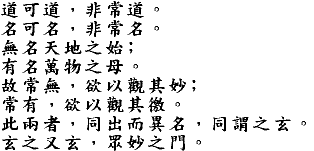MP3 Downloads
The audio recordings below are provided for your convenience. Please note that they are MP3 files extracted from YouTube videos, and the videos contain visual elements that cannot always be adequately conveyed through spoken words alone.
- Part 1: download from Google Drive
- Part 2: download from Google Drive
- Part 3: download from Google Drive
- Part 4: download from Google Drive
Paraphrase
The eternal Tao can never be completely described with spoken words or defined with written words. You cannot rely on words to understand it. You have to live it… and feel it.
As the source of universal creation, the Tao doesn’t really have a name. Human beings name it “Tao” as a label of convenience, in order to describe it as the beginning of everything — including life itself.
We apply this duality of “with” and “without” everywhere. For instance, having excessive desires get in the way; being free of desires lets us understand a situation with greater clarity.
This does not mean we should eliminate all desires. We need not just the essence without desires, but also the manifestation of desires. Both come from the Tao, and both must be integrated in life. This is the most profound lesson of all, and it leads to all the wonders of the Tao.
Interpretation
The Tao that can be completely explained or expressed with spoken words is not the constant, eternally unchanging and true Tao. Similarly, if the name of this Tao can be defined with written words, then it cannot be the constant, eternally unchanging name of the true Tao.
Names did not exist prior to universal creation. The nameless Tao is therefore the source of the universe. Once it manifests itself as the physical universe, it can be named. Everything is derived from it through natural processes. It is therefore the mother of all things.
If we approach the Tao without self-serving desires, we can readily observe its inner wonders and marvels. This establishes a direct connection with the source, the vast intelligence of universal consciousness. This is what gives us flashes of powerful, intuitive insights, as well as free-flowing creativity.
If we approach the Tao full of self-serving desires, then we can only observe its external physical manifestations, rather than its inner essence. These desires block the connection and interfere with the Tao process. This is something we often do to ourselves — we interfere with the best and most natural outcome that would otherwise come to fruition.
The Tao’s external manifestations (life, nature, the cosmos, and so on) and its inner wonders (oneness, the living void, the flow, etc.) are both properties of the ultimate reality. Although we call them by different names, they are but two sides of the same coin.
The unity of these two aspects gives us an interesting paradox. They seem distinctively different, and yet they lead to one another. Understanding of the Tao’s inner essence gives us greater understanding of its outer manifestations, and vice versa. Our recognition and acknowledgement of this paradox will open the door for us to further explore the infinite wonders of the Tao.
Thoughts & Reflections
The “Nameless Name” — that which existed before there was anything to name — is a synonym for the Tao.
The main idea is that the Tao is a concept beyond reason and logic. It is the universal principle that permeates every action and every phenomenon, but it cannot be adequately understood through the rational mind. To comprehend it completely, you must exercise your intuition and get in touch with the fundamental divinity that connects everyone and everything.
Lao Tzu is also pointing out the limitation of spoken words and written texts. Our tendencies to categorize, define and analyze only give us a limited view of how the Tao acts upon the material world. This is what can happen when we study physics, biology, chemistry, and other natural sciences.
On the other hand, if we free ourselves of this limiting human desire to put everything into words, and become aware of our wordless communion with nature, we can catch glimpses of a divine wisdom. Beyond categories, definitions, and analyses, this wisdom is far more profound than anything that academic knowledge, science and technology can offer.
Translation Notes
As noted in the presentation, the second 道 means to speak or be spoken. It does not mean to walk or be walked, to follow or be followed, to experience or be experienced. Thus, the translations below are erroneous:
- The way that can be trodden
- The Way that can be experienced
- The way that can be followed
- Those who would follow the way
One variant that can be acceptable as an alternative is to interpret 道 in the sense of arrival, similar to 到. This is rather speculative, but still possible because in certain ancient usage, 道 might be not just homophonic to 到 (same sound), but also synonymous to some degree.
In this perspective, the lines become “The Tao that can be arrived at / is not the eternal Tao.” The idea is similar to when we talk about life being a journey, rather than a destination — thus, the Tao of life is a process, rather than an end result.
- The Sad Lady - December 1, 2019
- Purchasing Yi - December 1, 2019
- The Seven Virtues of Water - August 21, 2018

